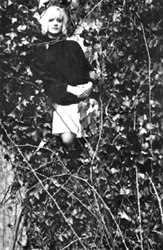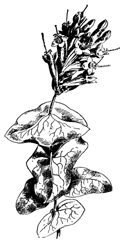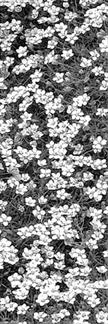 Go
Native!
Go
Native!Take a tip from Mother Nature as you build your garden
by Sharon Fitzpatrick
 Go
Native!
Go
Native!
Take a tip from Mother Nature
as you build your garden
by Sharon Fitzpatrick
As you begin to garden this season, beware of alien plants that endanger our ecology.
English ivy, for example, threatens in obvious ways by climbing trees, which harms bark and structure, and by covering the floor in woodlands, where native species should grow. This evergreen vine is so established in American soil that calling it invasive is an understatement.
To contend with English ivy, clear it from all tree trunks, remove non-essential patches and trim sections that serve a purpose, such as erosion control. Pay attention to mature vines, which are thick and woody, because blooms and berries form in order to spread the species.
For ground cover, consider Allegheny pachysandra or partridgeberry. You'll also find cleaning leaves from these low-growing evergreens much easier than out of large areas of ivy or periwinkle, another cultivar that evicts native species. If your garden design calls for an evergreen climber, plant wood vamp in shade or sun and expect a bonus of fragrant, white flowers.
Sharon Fitzpatrick, in her highschool yearbook, about to be devoured by English ivy.
Japanese honeysuckle, however, is a flowering vine to avoid. This aggressive immigrant overtakes territory by coiling on stems, trunks and anything in its upward path to dominion. A suffocated host supports a fertile mat with countless berries that birds eat and deposit, often near water.
 Instead, grow trumpet honeysuckle, left,
which belongs to the region and attracts hummingbirds. Another vine de cuisine
for hummingbirds is trumpeter creeper, a leafy climber that blooms all summer
with orange-red flowers. In fall, seed pods form like single bananas that
disburse potential offspring. Try taming some on a trellis at a distance
from tailored beds, then listen for the hum of iridescent birds and bugs
that come to feed. Remove wayward sprouts early in spring, when the tap-like
root is still corrigible, and in fall deter spreading by removing and disposing
of seed pods.
Instead, grow trumpet honeysuckle, left,
which belongs to the region and attracts hummingbirds. Another vine de cuisine
for hummingbirds is trumpeter creeper, a leafy climber that blooms all summer
with orange-red flowers. In fall, seed pods form like single bananas that
disburse potential offspring. Try taming some on a trellis at a distance
from tailored beds, then listen for the hum of iridescent birds and bugs
that come to feed. Remove wayward sprouts early in spring, when the tap-like
root is still corrigible, and in fall deter spreading by removing and disposing
of seed pods.
Another invader of wetlands, purple loosestrife, grows in groups of tall stalks with spikes of magenta blossoms. This prolific perennial seeds itself on land and also among grasses in waterways. A fast grower, it claims valuable real estate while indigenous grasses diminish in the Bay area.
If you desire a garden accent with height and purple flowers, there are several alternatives. Most similar, New York ironweed can grow up to eight feet and tolerates many conditions. Great blue lobelia, right, comes in astonishing shades of unusual flowers, and liatris creates attractive foliage with flower stalks perfect for fresh or dried bouquets. Pair purple coneflower with any of these for contrast and appeal to butterflies and goldfinches.
Remember that Mother Nature is the greatest landscaper, whose plan involves much more than aesthetics. Refer to her design in order to enjoy working with earth and with the Earth. Creating a biological haven can elevate your gardening experience to active conservation. Research. Explore your options and draw a plan. Call different suppliers to compare price and conditions. The most desirable plants are those raised organically, then those raised locally and only last those raised in greenhouses.
On the forefront of responsible horticulture, Environmental Concern Inc.
has been specializing in all aspects of wetlands since 1972. The St. Michael's
nursery offers native shrubs and trees, herbaceous plants and cordgrass
seed. They also consult and deliver. They're almost unique in that they
recycle plastics containers and flats, which can be returned to the nursery
or picked up by a company driver. They also teach courses on wetlands and
publish the quarterly Wetland Journal.
Nursery manager Sharon Griffith names phragmites as the main culprit
in local wetlands, but she remains optimistic about restoring balance. "I
think they're great," she said of the native plants she grows and sells.
"They're doing their job out there!"
In survival, all living beings endure struggle and competition. Botanical beings must attain space, sun, water, nutrients, means of propagation and resilience to disease and parasites. We have added to these inherent challenges the pressures of grappling with non-native neighbors and finding proper conditions in less area as we expand. As a consequence, we must be responsible for protecting biodiversity.
The luxury of beautiful landscaping should entail certain obligations: careful introduction of foreign species, limited application of artificial fertilizers and proper disposal of natural waste. Designate a place for debris on your property rather than allowing fuel to be burned, hauling your share of raw material.
Pretty but pervasive: periwinkle evicts native species.
Better yet, compost!
Composting can be an art of daily maintenance or an easy task that reduces the household's output of waste. Increase aeration in a compost heap with a few lengths of PVC piping. Drill holes in the plastic, then secure the pipes in the pile with the top exposed. Save compostable scraps (coffee grounds, grains, vegetable and fruit remains) in an empty milk jug. Cut a hole in the plastic, opposite the handle and recycle after use. When the compost turns to black gold, enrich your garden with this inexpensive, natural fertilizer, thereby completing a cycle.
Pristine ecosystems are intricate societies. Each member contributes to the whole, and waste is converted to energy. Our species should not be exempt from these animate rules.
Environmentalist Fitzpatrick works as a professional landscaper.
Learn more about native plants and find a fuller list of invaders to avoid in the U.S. Fish and Wildlife Service booklet Native Plants for Wildlife Habitat: 410/573-4500. Ask for Bayscapes homeowners guides, too.
| Issue 14 |
Volume VII Number 14
April 8-14, 1999
New Bay Times
| Homepage |
| Back to Archives |